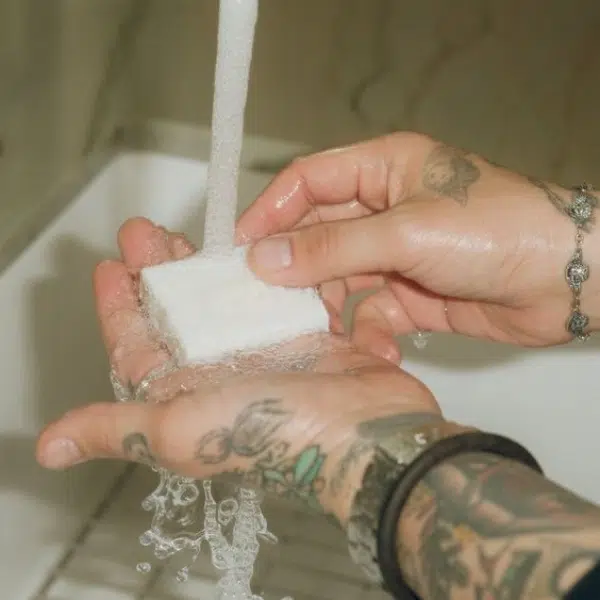Tattoos have evolved from being cultural symbols to personal expressions of art. They represent a significant part of an individual’s identity. However, the process of getting a tattoo doesn’t end with the final touch of the tattoo artist’s needle. Proper aftercare is crucial to ensure the longevity and vibrancy of your ink. Here’s a comprehensive guide to the dos and don’ts of tattoo aftercare, ensuring your body art stays stunning for years.

Fresh and Healed Tattoo Credit to @giuly_tattoo on IG
Dos of Tattoo Aftercare
1. Follow Your Tattoo Artist’s Instructions
After getting your tattoo, your artist will provide you with specific aftercare instructions. Please follow these guidelines carefully, as they are tailored to your unique tattoo and skin type. These instructions typically include how to clean the tattoo, what products to use, and how often to moisturize the area.
Your artist’s expertise and experience in the field make their guidance invaluable in ensuring proper healing and the preservation of the intricate details of your new body art. So, paying close attention to tattoo aftercare instructions is crucial. Because It can significantly impact the final outcome of your tattoo. In addition, it allows the tattoo to heal seamlessly and retain its intended beauty.
2. Maintain Cleanliness: Essential Steps in Tattoo Aftercare
Maintaining cleanliness is pivotal in preventing infections. Tenderly cleanse the tattooed area with a bar of mild, fragrance-free soap and lukewarm water, either using your hand or a soft, clean cloth. Afterward, gently pat the area dry with a clean towel, avoiding vigorous rubbing or harsh movements.

Source: https://www.pinterest.com/pin/316448311321613923/
It’s essential to maintain a gentle touch during the cleaning process to safeguard the delicate healing skin and preserve the intricate details of the tattoo design. Moreover, regular cleaning ensures that any excess ink, blood, or plasma is gently removed, allowing the skin to breathe and the tattoo to heal effectively.
3. Regular Moisturizing: A Key Element in Tattoo Aftercare
Applying a thin layer of fragrance-free, non-comedogenic moisturizer helps keep the tattooed skin hydrated and prevents it from becoming dry or itchy. Proper hydration not only aids in the healing process but also promotes the vibrancy of the ink, ensuring that the colors remain bold and the lines crisp over time.

Credit to @Mad Rabbit Tattoo | Pinterest
Be sure to apply the moisturizer gently, using clean hands, to avoid any potential irritation or infection. Use products recommended by your tattoo artist or those specifically designed for tattoo aftercare to ensure optimal results.
4. Protect Your Ink: Sun Shield Tips in Tattoo Aftercare
Sun exposure can cause the tattoo to fade and affect its clarity. So, It’s essential to shield your tattoo from direct sunlight. When exposed, use a broad-spectrum sunscreen with a high SPF to protect the ink from UV rays. Look for sunscreens formulated explicitly for tattoo protection, as they often contain ingredients that help preserve the vibrancy of the ink. Remember to reapply sunscreen regularly, especially if you’re spending an extended period outdoors.

Source: https://www.pinterest.com/pin/1829656090810797/
Additionally, consider covering the tattoo with clothing or a bandage if you anticipate prolonged sun exposure to provide an extra layer of protection. This proactive approach can significantly contribute to the long-term preservation of your tattoo’s original colors and intricate details.
5. Wear Loose-fitting Clothing
Avoid tight clothing that may rub against your tattoo, causing irritation or friction. Therefore, opt for loose, breathable fabrics that won’t stick to the tattooed area, allowing it to breathe and heal properly.

Credit to David Dvořáček | Unsplash
Additionally, consider wearing clothing that provides a protective layer over your tattoo, especially if it’s located in an area prone to rubbing against clothing or straps, to prevent any unnecessary friction or irritation during the healing process. This extra layer can also safeguard your tattoo from potential contaminants in the environment.
6. Maintain Proper Hygiene
Keep your hands clean before touching the tattoo to avoid introducing bacteria into the healing skin. Additionally, refrain from using public gyms or shared equipment that may harbor bacteria and cause infections. Avoid swimming in pools, saunas, or any activity that might expose your tattoo to unclean water during the healing process, as these environments can be breeding grounds for bacteria and harmful microorganisms that can jeopardize the healing process.

Credit to @Daily Mail on Pinterest
7. Eat A Healthy Diet and Stay Hydrated
You can consume a balanced diet rich in vitamins and minerals because it can promote skin health and accelerate the healing process. Incorporate foods high in vitamin C [1], zinc [2], and omega-3 fatty acids [3], as they contribute to collagen production and tissue repair. A diet abundant in fruits, vegetables, lean proteins, and whole grains provides the necessary nutrients to support your body’s healing mechanisms.

Credit to Sam Moghadam Khamseh | Unsplash
Furthermore, staying well-hydrated not only aids in the recovery of the tattooed area but also helps flush out toxins, keeping your skin supple and vibrant. So, strive to maintain a daily intake of 8-10 glasses of water. What’s more, you should be mindful of the consumption of dehydrating beverages like alcohol and caffeine. These drinks have the potential to hinder the healing process and impact the overall quality of your tattoo.
8. Attend Follow-up Appointments for Tattoo Aftercare
If your tattoo artist recommends a follow-up visit, make sure to attend it. These appointments allow the artist to assess the healing progress and make any necessary touch-ups to ensure your tattoo looks best. For example, your artist’s expert eye can identify areas that may need additional color or shading and can address any concerns you might have about the healing process. It’s a valuable opportunity to discuss any potential adjustments to your tattoo, ensuring that it meets your vision and expectations.

Credit to @P&Co on Pinterest
Additionally, maintaining a relationship with your artist through follow-up appointments can be excellent because you can seek advice for future tattoo projects and express appreciation for their artistry.
Don’ts of Tattoo Aftercare
1. Don’t Pick or Scratch the Tattoo
Resist the urge to pick at scabs or scratch the tattooed area, as doing so can not only disturb the delicate healing process but also increase the risk of introducing harmful bacteria, leading to potential infections.
Remember that the development of scabs is a natural part of the healing process, and interfering with them prematurely can result in scarring or uneven pigment distribution, compromising the aesthetic integrity of your tattoo. After all, trust the healing process and allow your skin to recover naturally for the best long-term results.
2. Avoid Submerging the Tattoo in Water
While your tattoo heals, avoid swimming, soaking in hot tubs, or taking long baths. Prolonged exposure to water can soften the skin, making it more susceptible to damage and infection. Water can also carry harmful bacteria and contaminants that pose a risk to your healing tattoo. Instead, opt for quick, gentle showers, and be cautious when washing the area to prevent unnecessary moisture and stress on your new ink.

Source: https://removery.com/blog/infected-tattoo-stages/
3. Don’t Use Harsh Chemicals or Products of Tattoo Aftercare
Avoid using products containing alcohol, fragrances, or exfoliants on the tattooed area because they can cause irritation and slow down the healing process. These harsh ingredients can disrupt the delicate balance of your skin, leading to inflammation and potentially affecting the appearance of your tattoo. Therefore, it’s essential to stick to the products recommended by your tattoo artist, as they have experience and knowledge about what works best for your specific tattoo and skin type.
By using the right products, you not only promote proper healing but also ensure that your tattoo retains its brilliance and clarity, allowing it to stand the test of time as a lasting work of art on your skin.
4. Don’t Cover the Tattoo with Tight Bandages
Allow your tattoo to breathe. Avoid wrapping it in tight bandages or plastic wraps because they can create a breeding ground for bacteria and hinder healing. Excessive moisture trapped under tight bandages or wraps can lead to bacterial growth, increasing the risk of infections.

Credit to @✨𝒄𝒆𝒓𝒕𝒊𝒇𝒊𝒆𝒅𝒑𝒉𝒂𝒕𝒕𝒚✨ on Pinterest
Additionally, covering the tattoo restricts airflow, which is crucial for healing. Letting the tattoo breathe ensures it receives an adequate oxygen supply, promoting faster healing and reducing the chances of complications. If your tattoo artist recommends a specific covering for the initial healing period, ensure it is breathable and not excessively tight. After all, always follow their guidance to facilitate the optimal healing of your tattoo.
5. Don’t Ignore Signs of Infection
If you observe any indications of infection, including pronounced redness, swelling, or the presence of pus, please seek immediate guidance from a healthcare professional. Prompt treatment is crucial to prevent further complications and ensure proper healing.
Ignoring infection symptoms not only jeopardizes the appearance of your tattoo but can also lead to more serious health issues. Infections left untreated can result in scarring and may require antibiotic therapy, so it’s essential to address any concerns as soon as they arise. Remember, your safety and the preservation of your tattoo’s integrity should always be a top priority.
6. Don’t Engage in Activities that Cause Excessive Sweating
Sweat can irritate the tattooed area and slow down the healing process. Avoid rigorous physical activities or exercise that leads to excessive sweating until your tattoo is fully healed. So, consider opting for low-impact activities or exercises that don’t put significant strain on the tattooed area. It’s essential to give your body ample time to recover and allow the tattoo to heal without complications. Moreover, taking a temporary break from intense workouts can significantly contribute to the proper and timely healing of your new tattoo.


What a new tattoo looks like after going to the gym.
Credit to @katiejoh on Reddit
Bottomline of Tattoo Aftercare
Taking care of your tattoo is not just about preserving the art; it’s about nurturing a piece of your story that is etched onto your skin. By following the dos and avoiding the don’ts, you are not just protecting the ink but also honoring the journey that led you to that particular design.
Remember, the aftercare process is not just about healing the skin; it’s about embracing the transformation it represents in your life. Therefore, cherish the memories, experiences, and emotions your tattoo embodies. Let it be a constant reminder of your strength, passions, and unique identity.
Above all, as you embark on the journey of tattoo aftercare, treat it as a ritual of self-care and self-expression. Embrace the healing process with patience, and watch as your tattoo evolves into a timeless piece of art that narrates your personal tale to the world.
In the end, if you want to get a tattoo, we also provide some tattoo shop guides and unique tattoo designs for your reference.
- 9 Best Tattoo Shops in the United States
- 11 Best Tattoo Shops in New York City
- 10 Best Tattoo Shops in Los Angeles
References:
- DePhillipo, N. N., Aman, Z. S., Kennedy, M. I., Begley, J. P., Moatshe, G., & LaPrade, R. F. (2018). Efficacy of Vitamin C Supplementation on Collagen Synthesis and Oxidative Stress After Musculoskeletal Injuries: A Systematic Review. Orthopedic journal of sports medicine, 6(10), 2325967118804544.
- Tengrup, I., Ahonen, J., & Zederfeldt, B. (1981). Influence of zinc on synthesis and the accumulation of collagen in early granulation tissue. Surgery, gynecology & obstetrics, 152(3), 323–326.
- Hankenson, K. D., Watkins, B. A., Schoenlein, I. A., Allen, K. G., & Turek, J. J. (2000). Omega-3 fatty acids enhance ligament fibroblast collagen formation in association with changes in interleukin-6 production. Proceedings of the Society for Experimental Biology and Medicine. Society for Experimental Biology and Medicine (New York, N.Y.), 223(1), 88–95.




